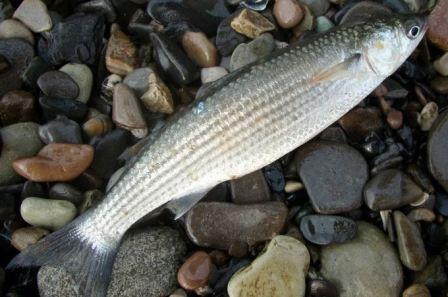Leaping mullet fish description and breeding in mariculture

The leaping mullet fish, together with flathead grey mullet, Golden grey mullet and so-iuy mullet, is a commercial fish, an object of aquaculture; the leaping mullet is readily caught by amateur fishermen.
Content
- Description of leaping mullet fish
- What is leaping mullet fish
- Where does the leaping mullet fish live?
- What does a leaping mulletd fish look like?
- Eating leaping mullet fish
- Leaping mullet lifestyle
- Leaping mullet Spawning
Description of leaping mullet fish
What is leaping mullet fish

The Leaping mullet fish, whose Latin name is Liza saliens, belongs to the Mullet family - Mugilidae.
Where does the leaping mullet fish live?
The Leaping mullet fish is a marine fish that sometimes enters river mouths, but mainly lives in the sea, where it can tolerate high salinity of water.
The Leaping mullet fish lives in the Eastern Atlantic from the Bay of Biscay to Morocco, and inhabits the Mediterranean and Black Sea. In the Black Sea, leaping mullet fish are found in large quantities in the western part of the sea. In summer, the leaping mullet enters the Sea of Azov. In the Caspian Sea it is an object of fishing.
What does a Leaping mulletd fish look like?
What does Leaping mullet fish look like? The snout of the Leaping mullet is pointed, which is what gave it its name, and lacks scales in front of the front nostrils. Leaping mullet eyes without fatty eyelid. The blade at the base of the pectoral fin is absent.
What color is the pointed nose? The color of the leaping mullet ranges from dark gray to dark brown, the second dorsal fin and the lower part of the caudal fin are black at the edges, the pectoral and ventral fins are completely black.
The Leaping mullet is not the largest mullet; in the Caspian Sea, the length of the Leaping mullet reaches 40 cm.
Eating leaping mullet fish
What does the Leaping mullet eat? Leaping mullet fry, 5–10 mm in size, feed on small planktonic organisms. As the leaping mullet grows, it begins to feed on mollusk larvae, and after approaching the shore it feeds on bottom animals: chironomids, gammarus, and shrimp larvae. Upon reaching a length of 6 cm, the fry completely switch to feeding on detritus.
Leaping mullet lifestyle
Adult Caspian Leaping mullet winters in the Southern Caspian Sea. In February, it begins to move along the western and eastern coasts, reaching the desalinated areas of the Northern Caspian by May. By November it returns to the Southern Caspian. By the end of autumn, all the juveniles concentrate in the Southern Caspian Sea, continuing to feed in winter.
Leaping mullet Spawning
Sea schooling fish. In the Caspian Sea, the Leaping mullet spawns from May to October at a water temperature of 20 to 29° C. Mass spawning in the Southern Caspian occurs at night in late July - early August at a water temperature of 27–29° C. Fecundity averages 1,300 thousand. caviar. The eggs are spherical, floating, with a drop of fat. The development of eggs lasts about a day. Scales in fry appear at a length of 11–11.5 mm. By September, the average length of the Leaping mullet is 34 mm. Females of the Leaping mullet begin to mature in the third year of life at a length of 22 cm, and males in the second year at 19–20 cm.